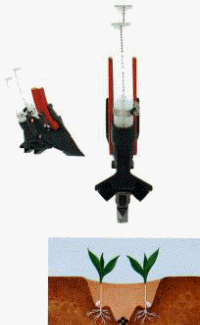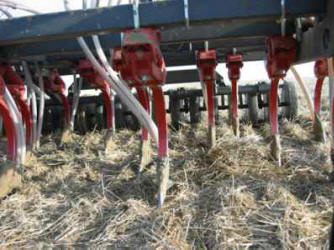Change from Conventional Tillage
To
Minimal Tillage
Rotation before change:
Peas,
Winter or Spring Wheat
Beans,
Winter or Spring Wheat
Flax, Mustard or Canola
Spring Barley
Tillage before changing to Min-Till:
Plough after flax every six years, straw incorporation with chisel plough and double disk, seed bed preparation with vibra-shank/harrow packer.
On average four to five passes plus seeding operation.
Change To Minimal Tillage:
2000
No change in crop rotation.
Problems and modification of operation:
2000
2001Winter wheat seeding (custom seeded) into standing, spring wheat stubble.
Good emergence, but the crop showed Nitrogen-deficiency in spring, because we could not get on the field with fertilizer before May. The crop recovered well after we fertilized, but could not achieve optimum yield.
Seeding of peas, winter wheat, flax, and spring barley with our own equipment (Flexicoil 5000 with 1720 Tank stealth openers)
|
Stealth Openers |
 |
 |
Winter wheat - good seed placement, good stand and yield.2002Peas - no problems observed, good stand and good yields
Flax - seeded to deep, uneven germination and uneven stand. We made the mistake to place the seed with the front chisel and the fertilizer (80 N + 30 P2O5) with the rear spreader.
Spring barley - good seed placement, good stand and yield.
Mustard - good seed placement, good stand and yield.
No Beans this year
*** We learned, that we could decrease seeding depth with the change to minimal tillage and direct seeding because of better water holding capabilities in the top 2 inches.***
Winter wheat - good seed placement, good stand and yield.2003Peas - good seed placement, good stand and yield.
No flax this year
Spring barley - good seed placement, good stand and yield.
Mustard - good seed placement, good stand and yield.
No Beans this year
**abnormal rain fall in 2002 gave us very wet seeding conditions in 2003**
Winter wheat - good seed placement, good stand. Problems spring 2003: to wet for timely weed control, deep tracks from spraying.2004Peas - very late seeding (one month later then normal), wet conditions leading to bad emergence, late harvest and problems with late germinating weeds (kochia).
No Flax this year
No Spring barley this year
Mustard - good seed placement, good stand and yield.
Beans - single pass with double disk and harrow packers. Good stand, warm summer very good yield.
Winter wheat - good seed placement, good stand and yield.
Peas - first problems with heavy straw loads after durum wheat on rented land, diagonal harrowing did correct this problem. Good stand and yield.
No Flax this year
Spring barley - good seed placement, good stand and yield.
Beans - thick straw matt on all fields dedicated for beans. Single double disking with harrow packer did not burry this straw matt. In addition we had very cool and wet weather with low soil warmth, resulting in slow and uneven germination. A cool summer increased our problems, luckily we had no frost in September and harvested a normal yield with average quality.
We learned for our growing conditions, that minimal till has clear advantages, but several aspects need to be considered and respected:
Must's:
Cost of the Seeding Technology
Total machinery costs plus fuel and wages decreased by about 70%. Yields did not go down, we rather feel that they are on an upward trend. It is important to understand and realize that min-till fields can not be compared with the conventional farmed fields of the neighbours.
Burn-off with roundup before or after seeding is a very important operation.
Positive depth control on our Flexicoil 5000 is certainly not optimal, but it is questionable, if the change to a Barton type opener can warrant the high purchase price and increased maintenance costs. We also like the capability to apply high fertilizer amounts with the double shoot setup.
A positive fact is the better seed bed utilization, with the 3" band width of our double shoot stealth opener.
For beans, we will have to stick to a field cultivation until we find suitable technology that is affordable.
Contact us at:
Klempnauer Farms
P.O. Box 657,
Grassy Lake, Alberta
Canada T0K 0Z0
Phone: 1-403-655-2507
Fax: 1-403-655-2230
Jörg Klempnauer
E-Mail: joerg.klempnauer@klempnauer.ab.ca
Mobile: 1-403-330-5480
Petra Klempnauer (Chief Administrator)
E-mail: petra@klempnauer.ab.ca
® All Rights Reserved
For problems or questions regarding this Web site contact
Jens Klempnauer.
Last updated:
03/10/06.